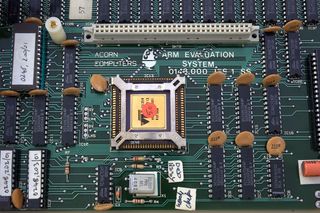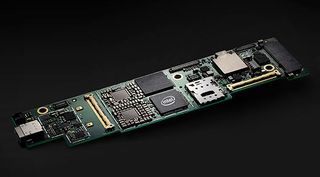What Apple's move to ARM could mean for PC and console gaming
Could a major change be coming to the insides of our PCs?

This article originally appeared in issue 348 of our glossy magazine. You can get it delivered right to your door by grabbing a subscription, which will also net you special subscriber-only covers.
You may have missed it, but for the third time in its existence phone company Apple is moving its desktop computers to a new CPU architecture. This time, from the Intel X86-64 chips it moved to in 2006/7 and with which we're familiar with from our PCs, to its own designs based on the ARM chips we're familiar with from our smartphones and tablets.
Arm produces designs for RISC (Reduced Instruction Set Computing) chips and licenses them for other people to make. They're in 98 percent of mobile phones. RISC chips have a few benefits over CISC (Complex Instruction etc) in that they are more efficient, use less power and can be easily designed. But they're more reliant on properly written software and fast memory. Arm has also recently been acquired by Nvidia, although the deal is not yet completely ratified.
The move has been mooted for a while, dating back to 2009 when Apple bought processor company PA Semi to develop chips for its iPods and iPhones, starting with the 800MHz, single-core, A4 chip in the 2010 iPhone 4 and first-generation iPad. Since then, the power of the chips has grown hugely, with the 2011 iPhone 4S (Apple A5, dual-core, 1GHz) showing a 68 percent gain in speed, and the A12X Bionic chip in the iPad Pro (2018, eight cores, 2.49GHz, seven GPU cores) showing benchmark results on a par with a Core i7, and AMD's Durango 2 graphics chip for the Xbox One S.
Back in November, Apple announced its first Macs to be based on its own Apple silicon processor, the Apple M1, thus kickstarting the two-year timetable it has put in place for the move to Apple silicon. The M1 is an impressive beast, too, as early performance figures allude to. Apple's custom silicon is keeping up with high-end x86 processors from Intel and AMD just fine, it seems. And that's often even with the Rosetta2 software translation layer running in order to get some key x86 programs to run. That'll actually become less important as developers make the shift to support Apple's silicon natively. But all in good time.
So what does this mean for our Intel—and AMD—dependent PCs? Apple is said to account for between two and four percent of Intel's sales, so there's no chance of Intel going bust any time soon, but if the computer of choice for architects, graphic designers, and techies has made the jump to ARM designs, what could be next? PlayStation 5 and Xbox Series X are firmly in the X86 camp with their AMD chips, but Nintendo implements an ARM design in the Switch with its Nvidia Tegra chip. Could PlayStation 6 use ARM? Could your next PC?
Switching it up
I spoke to Miguel Angel Horna, tech lead at game porting specialist Blitworks, which recently looked after Larian's Divinity: Original Sin II on its journey to the Switch, about how the two platforms differ. "From a programming perspective, modern compilers do a very good job of abstracting the architecture, so programming for any of the current platforms feels essentially the same," he says. "The biggest difference is mainly in the available performance. Usually, ARM platforms include less powerful CPUs and low-power GPUs, and this is important when you're trying to run a game at the best possible framerate. Sometimes the difference is minimal, sometimes the difference is big, it depends on the game."
What about PCs though? "On PC you have lots of cores, lots of memory so it's easier to work with," says Horna. "When moving [your code] to a home console, you have to start being careful, as there is a lot of available performance but you can only unlock it if your code is correctly laid out. The most difficult thing is moving [code] to a mobile architecture, where the performance is apparently there, but you can only get it if you are extra careful when laying out your code."
The biggest gaming news, reviews and hardware deals
Keep up to date with the most important stories and the best deals, as picked by the PC Gamer team.

ARM has made great strides, implementing 64-bit modes and improved floating point support. "In the last years, both architectures have converged on a similar set of features that makes programming for any platform virtually transparent," says Horna. "As long as a portable language is used – C or C++ are the ones mainly used for games. X86 once lacked something that ARM architectures have: plenty of registers for the compiler to generate more optimised code, but this changed with x64, and now both platforms are very comparable in terms of supported instructions, and also even in single-core performance. One thing is clear, with enough programming effort you can counteract the difference in performance, and that's why you can find games running on the Switch that were almost unthinkable a few years ago."
So it looks like we're seeing a convergence of hardware rather than one architecture dominating the other, with any gaps being filled in by software. Through this lens, Apple's decision seems more to do with taking control over the manufacturing of its CPUs than any 'death of Intel' scenarios. Apple is the only manufacturer of its hardware, even if it buys in chips, RAM, and SSDs from outside. A PC, in contrast, can contain tech from any number of AIB makers.
ARM-less

"We don't think home consoles will change to ARM anytime soon," says Horna. "Mainly because of the way they are built. The technology is so complex that no manufacturer can do it on their own, they instead ask a chip manufacturer to do a custom design. There are very few companies capable of doing that: PC chip manufacturers and mobile chip manufacturers. Each is focused on a particular segment, usually performance on PC and efficiency on mobile. So while technically possible, it's not likely that a mobile chip manufacturer will suddenly start developing a super-high-performance chip, as it will have very few customers for it.
Even Apple, whose chips are constantly challenging what we expect from mobile chips, is still embedding low-power GPUs that can't quite compete with their desktop counterparts. "Our expectation is that we'll continue to see desktop components used in the most performant consoles, while mobile chips will be reserved for portable consoles or other lightweight devices such as the Apple TV." To extend this, the x86 CPU in your PC is probably safe until desktop PCs and portable devices merge.

Ian Evenden has been doing this for far too long and should know better. The first issue of PC Gamer he read was probably issue 15, though it's a bit hazy, and there's nothing he doesn't know about tweaking interrupt requests for running Syndicate. He's worked for PC Format, Maximum PC, Edge, Creative Bloq, Gamesmaster, and anyone who'll have him. In his spare time he grows vegetables of prodigious size.
Most Popular

